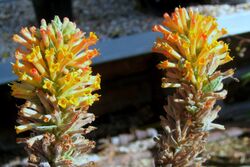Biology:Buddleja tubiflora
| Buddleja tubiflora | |
|---|---|

| |
| Buddleja tubiflora panicles | |
| Scientific classification | |
| Kingdom: | Plantae |
| Clade: | Tracheophytes |
| Clade: | Angiosperms |
| Clade: | Eudicots |
| Clade: | Asterids |
| Order: | Lamiales |
| Family: | Scrophulariaceae |
| Genus: | Buddleja |
| Species: | B. tubiflora
|
| Binomial name | |
| Buddleja tubiflora Benth.
| |
| Synonyms | |
| |
Buddleja tubiflora is endemic to much of northern Argentina , southern Paraguay, and southern Brazil , where it grows at the edge of woodlands, thickets, and in old fields, at low elevations. The species was first named and described by George Bentham in 1846.[1][2]
Description
Buddleja tubiflora grows to < 2 m in height, with the typically lax habit creating a spread of < 3 m. The shrub is chiefly distinguished by its striking orange flowers, the corollas 25 mm long by 6 mm wide at the throat, borne in axillary clusters towards the ends of the branches. The branchlets, like the corolla tubes, are covered in a dense reddish indumentum. The leaves are mostly subsessile, lanceolate to ovate-lanceolate, 8 – 18 cm long by 2 – 6 cm wide, membranaceous, tomentulose above, tomentose below. Pollination is by hummingbirds which feed on the sweet nectar at the base of the corolla. Ploidy: 2n = 38.[2]
Cultivation
Buddleja tubiflora is cultivated in the UK, most if not all specimens derived from a long-lost example grown at the Hanbury Gardens at Mortola Inferiore, Italy. A specimen is grown under glass as part of the NCCPG national collection at Longstock Park Nursery, near Stockbridge. The shrub can be grown on a south-facing wall in coastal areas of the UK, with added protection against frost, although waterlogging overwinter is considered a greater danger to the plant.[3] Hardiness: USDA zones 9–10.[3]
References
Wikidata ☰ Q4984733 entry
 |

